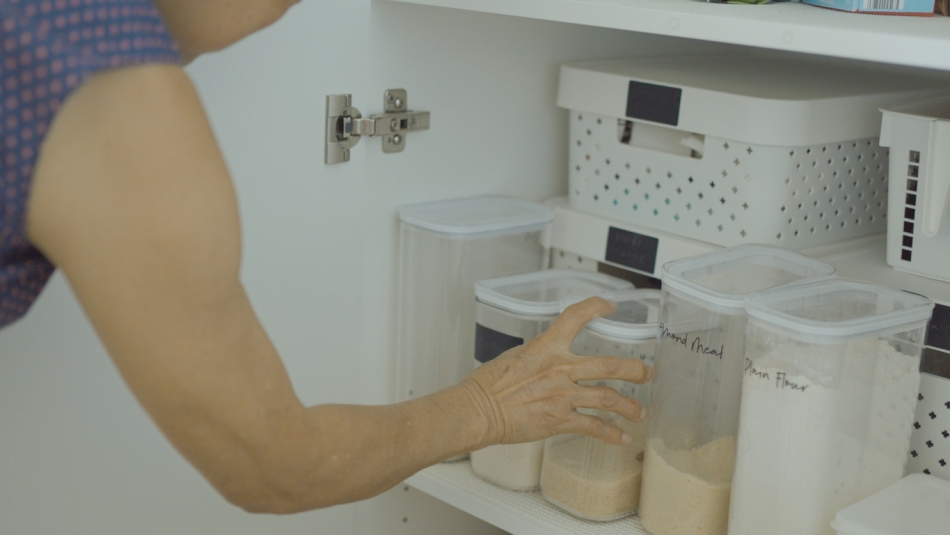Downsizing to a smaller home can feel overwhelming, especially for seniors who may be parting with decades of cherished items. However, with the right approach, downsizing presents an opportunity to simplify and organize your living space for better comfort and increased accessibility. Let’s explore some practical storage solutions and tips that make downsizing smoother and help maintain a clutter-free, safe environment.
Practical storage solutions for seniors with limited mobility
Accessibility is key when designing storage for seniors with limited mobility. Storage options should reduce the need for bending, reaching, or heavy lifting.
Here are some ideal solutions:
- Adjustable Shelving: Raise or lower shelves to customize them to a comfortable height.
- Pull-Down Kitchen Shelves: Keep frequently used items within easy reach.
- Storage Bins with Wheels or Handles: Easily transport heavy items without lifting them. These can be tucked under beds or in closets, maximizing space while keeping items accessible.
- Wall-Mounted Organizers: Keep important items like remote controls or medications visible and within arm’s reach.
Smart Home Technology: Voice-activated systems for lights, thermostats, and security help seniors control their environment without having to move. These technologies create a safer, more accessible home.
How can seniors maximize small spaces in their new homes?

Moving into a smaller space requires thoughtful planning to use every inch wisely. Here are some space-saving ideas designed for seniors:
- Compact Furniture: Multifunctional pieces like ottomans with hidden storage compartments or beds with built-in drawers reduce clutter and provide easy access to essentials.
- Vertical Storage Solutions: Tall bookshelves or hanging storage units free up floor space. Stackable storage baskets and pull-out pantry racks make kitchens and closets more functional.
- Space-Saving Design: Inspired by tiny home principles, foldable tables, nesting chairs, and wall-mounted desks can be stored away when not in use.
- Lighting and Color Choices: Lighter shades and brighter lighting make rooms feel more open, enhancing the comfort of a downsized home.
What are some practical downsizing storage tips for seniors?
Decluttering is the essential first step when you decide to downsize. Practical downsizing storage tips focus on functionality and emotional management. Start by sorting through belongings room by room, keeping only what is necessary and most meaningful. This manageable step-by-step process helps ease the emotional burden of parting with sentimental items.
Here are some practical downsizing tips:
- Sturdy Shelving Units: To stay safe while decluttering, avoid stacking boxes too high.
- Labeling Storage Bins: Help easily identify the contents, minimizing the need to search through boxes.
- Digital Storage Solutions: Scan important documents or digitize photos to free up physical space and preserve important memories without bulky filing cabinets or photo albums.
Emotional Downsizing: Parting with sentimental belongings can be challenging. Create a memory box for special items or consider gifting treasured belongings to family members, keeping the memories alive in a more compact and organized way.
What safety considerations should seniors keep in mind when organizing storage?
Fall prevention should be a top priority. Here are some important safety tips for organizing storage:
- Store Heavier Items at Waist Height: Minimize the risk of injury from bending or reaching.
- Use Open Shelving or Clear Containers: Allow seniors to see what’s inside without moving heavy lids or drawers.
- Motion Sensor Lighting: Install in closets or hallways to reduce the risk of tripping.
- Mobility Aids: Install grab bars in key locations like bathrooms and hallways to assist with movement.
- Non-Slip Mats: Place in storage areas to reduce the risk of slipping.
How can seniors keep their homes clutter-free while maintaining accessibility?
 Clutter can quickly accumulate in any home. It’s essential for seniors to maintain a tidy space for their safety and comfort. One effective strategy is to adopt a one-in-one-out rule: for every new item they bring into the home, something old should be removed or donated. This ensures that clutter is consistently kept in check.
Clutter can quickly accumulate in any home. It’s essential for seniors to maintain a tidy space for their safety and comfort. One effective strategy is to adopt a one-in-one-out rule: for every new item they bring into the home, something old should be removed or donated. This ensures that clutter is consistently kept in check.
It’s important to incorporate small, simple habits to keep things clutter-free as time goes on. For example, returning items to their designated place after each use can go a long way toward keeping a space organized. Decluttering regularly, even if it’s just a quick tidy-up each week, can prevent clutter from building up and overwhelming the home.
Additional tips for safe and efficient moving
Enlisting a moving company with specialized knowledge can make the process easier for seniors embarking on the downsizing journey. Companies that have services geared toward senior relocations understand the unique challenges of moving later in life. Services like packing, organizing, and unpacking can give you a jumpstart on the process.
Involving family members can also ease the emotional and logistical burden of downsizing for seniors. Having loved ones help with sorting, packing, and organizing can make the process smoother and create opportunities to reminisce and share memories.
Looking for assistance with downsizing? Contact us today for personalized moving and storage solutions for seniors


